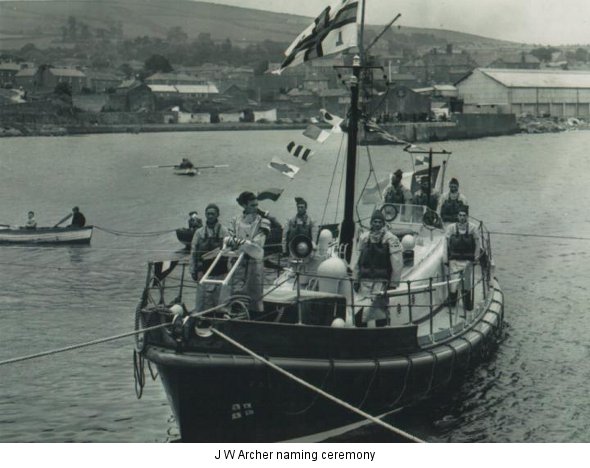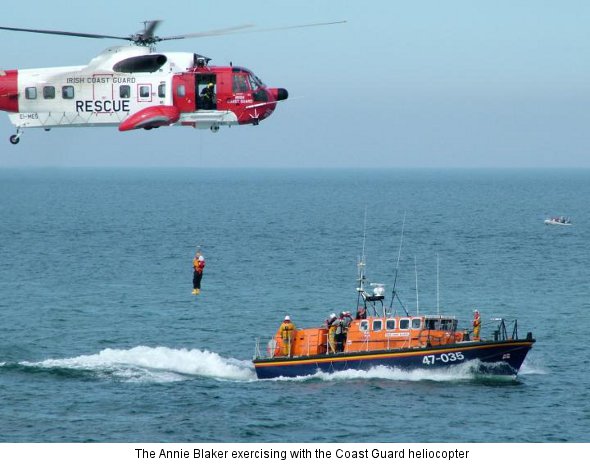Journal Volume 6 2010
One Hundred and Fifty Years of Lifeboating in North Wicklow (continued/1)
The War Years
The First World War saw the Wicklow Lifeboat launch eleven times on service. Two services during this time are particularly interesting and show the human face of war. On the 29th March 1917 the Wicklow Lifeboat launched to the rescue of the crew of the SS Wychwood, which had been sunk by the German U-boat, U65. All 18 crew were rescued and brought ashore at Wicklow. The interesting thing about this service was that in the 1980s an elderly gentleman visiting Wicklow asked at the station to see the service records for 1917. On inspection he decided that the dates were correct and it was the SS Wychwood he was interested in. On checking the station records and discovering that all crew were saved, he was relieved. It turned out he was one of the U boat crew, and always wondered if anyone escaped that night.
The same year, on the 29th August, the SS Lynburn struck a mine and sank within four minutes near the North Arklow Light Vessel. The Wicklow lifeboat launched to her assistance. After picking her way through the minefield, she picked up three survivors, the Captain, Mate and Engineer, clinging to some wreckage. The lifeboat continued to search for survivors and only turned back on the insistence of the Captain, who reckoned that the lifeboat crew had put themselves at enough risk and that he did not want them to risk their lives any further. A difficult decision. A letter of appreciation and thanks was received at the lifeboat station from Rev H R Cadwallader of the Congregational Chapel in Moelfre, Wales, where the master and many of his crew hailed from.
During World War II, the Wicklow lifeboat launched a total of ten times. Interestingly, apart from one ship that grounded after being chased by a U-boat, none were casualties of hostilities. The normal risks of going to sea continue, even in wartime.
A Medal Service
The RNLI recognise their coxswains and medals bravery and dedication, and every year an Awards Ceremony is held at London. Awards are not given lightly and most years only two or three gallantry medals are awarded. One such medal, a Bronze Medal for Gallantry, was awarded to Coxswain Ned Kavanagh after the successful rescue of ten crew from the MV Cameo, wrecked on the Arklow Bank.
The motor lifeboat Lady Kylsant, placed on station in 1937, was first launched on Sunday 10th September at 10.30 in the morning and stood by for several hours before returning to station. On Monday 11th, she was again launched and stood by with two tugs for ten hours in deteriorating weather. Finally, conditions reached a point where the ship’s captain decided the abandon ship and the lifeboat was again called at 9.30 on the night of Tuesday 12th, when she took the crew off the Cameo arriving back at Wicklow Harbour at 4.00 the following morning.
Recent Times
The 42 foot Watson Class Lifeboat, J W Archer, arrived on station in 1956 and shortly afterwards was officially named by Mrs Sean T O’Kelly, wife of the then President of Ireland. By the time of the lifeboat’s retirement in 1987, she was the only non-self-righting boat left in the Irish fleet. In her station life, she launched one hundred and sixty nine times, and saved seventy-five lives. The RNLI categorises its services according to the risk to the casualty. A ‘life saved’ is where it is deemed that but for the presence of the lifeboat, a life would have been lost.

The replacement for the J W Archer, the Annie Blaker, was a state of the art boat, self-righting and fully equipped with all the modern navigation and communications equipment. Arriving on station in 1989, cover being provided by relief lifeboats in the intervening two years, she was formally named by President Hillary.
Nothing remains constant and in recognition of the changing profile of services, the RNLI supplemented the Annie Blaker with a ‘D-Class’ Inshore Lifeboat in 1995. This inshore inflatable lifeboat, although only 16 feet in length, is no less a lifeboat than the forty seven foot Annie Blaker.



